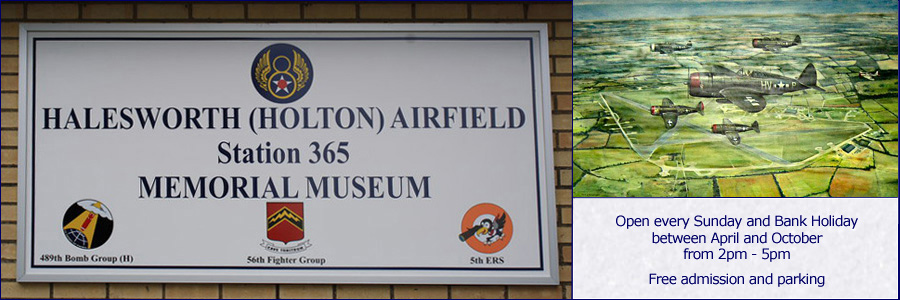The Official Newsletter of the 56th Fighter Group Memorial Association Friends of the 489th Bomb Group and 5th Emergency Rescue Squadron Friends - Summer Edition - July 2020 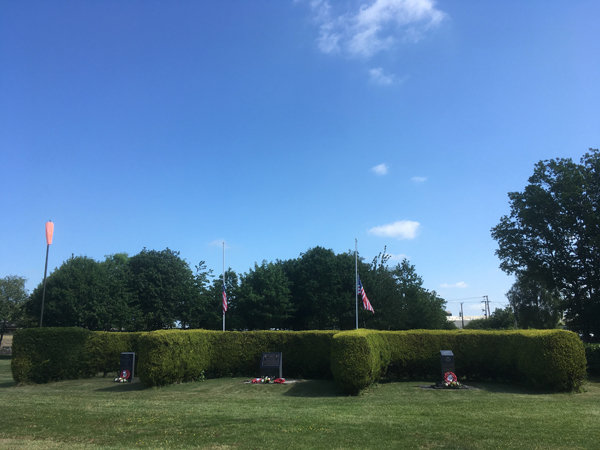
Summer is here and we are still living in strange times. The Covid-19 virus is still with us but we know things will get better.
Due to the ongoing virus Regulations and Conditions we cannot open the museum to the public for the 2020 season, but our volunteers are still working to keep the museum ready for when we can finally open to visitors. If we have a special request from a veteran’s family who may be visiting the area this year, we can look into opening for them on a one-off basis.
We, the museum volunteers, are grateful for the ongoing support of the Bernard Matthews company and of their security team who are always on site.
We will let you know via the Website/Facebook of any changes to openings.
Keep safe and well.
THE MUSEUM COLLECTION
As you cannot physically come to the museum during this 2020 Season, we thought you might like us to bring some of our collection to you. As well as our collection of local artefacts, we have been lucky over the years to have received donations of personal memorabilia, photos, official papers, books, framed prints, original artworks from a multitude of families, friends, and from our veterans themselves. For this we are really grateful. The various ‘Collections’ have been shared by them in order to be displayed and seen by all generations.
In this newsletter, we will bring you a few items, connected to one aircraft: the B-24 ‘Lonesome Polecat’, assigned to the 489th Bomb Group during 1944. We are aware of two different crews who flew in this - the Bishop Crew and the Sherburne Crew.
During WWII young local lad Eric Bacon befriended the Bishop crew who made him welcome in both their nissen hut quarters and also at Holton Hall where the commissioned crew were billeted. Eric said that one of the airmen, Eugene Shultz, “…could only have been 6-7 years older than myself, but he found time to teach me mathematics and encouraged me to follow the sciences, …subjects which he himself studied after the war.”
Young Eric kept a scrapbook in which he pasted photos of the airmen and information. He generously presented his book to the museum some years ago. He notes in the book that … “the quality of the food in the Mess or Chowhouse was very good, and I should know as I enjoyed many meals therein.”
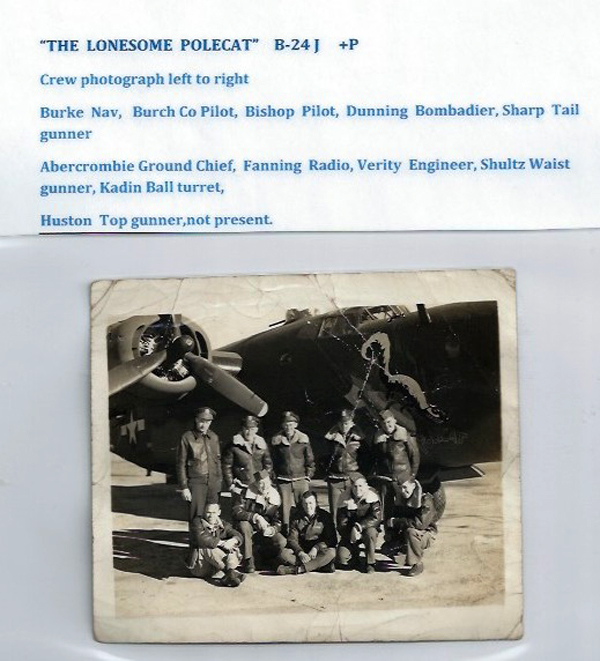
One of Eric’s American friends carved him a wooden B24 and the ‘Lonesome Polecat’ image was painted on its nose by the airman who painted the original nose art on the B-24. Eric has donated his treasured model to the museum and it can be seen displayed along with a ‘kit’ version Eric made some years later.
The ‘Lonesome Polecat’ was later flown by the Sherburne crew. Pilot Dick Sherburne told how the B-24 crashed not far from the airfield on its return from a mission, with the loss of one of his crew. Dick was quoted in Charles Freudenthal’s book ‘A History of the 489th Bomb Group’, … “the number 3 engine failed en route to Hamm... on the way back both the electric and hydraulic systems failed”. Shortly before they could get into the landing pattern the number 4 engine also gave up. Crew members were in the emergency landing positions but George Hammett, ball turret gunner was killed while trying to lower the nose wheel manually. Dick said “I think ‘Lonesome Polecat’ was just battle weary. It just fell apart, with no indication of any battle damage.”
Dick Sherburne donated photos of the B24, taken after the crash on Wheatacre Marshes. We also have the night-flying curtain from ‘Lonesome Polecat’ on display in the museum. Some years later, Beccles author, Dick Wickham wrote to the Pilot and we have his own account in the museum.
Just a couple of years ago, the family of another 489th veteran sent us a photograph of the B-24 ‘Lonesome Polecat’ - the clearest photo of the nose art we have seen. Thanks to the Robinson family for sharing the WWII photos which had been taken by Lt Gilman Sund who lost his life on 27 September 1944 in a tragic incident over Walberswick marshes.
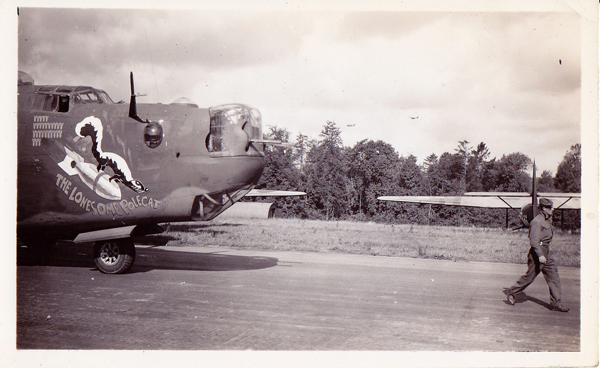 This was just one B-24 Liberator but it has generated additions to the Collection from four different sources. Is this a record?
This was just one B-24 Liberator but it has generated additions to the Collection from four different sources. Is this a record?
We will look at other items from our Collection in future Newsletters.
MEET THE TEAM
The museum could not run without the dedication of the volunteers. We thought it might be a good idea to introduce them to you over the course of the next few newsletters.
Paul Muttitt became a member of the team in April 2019. He has had a lifetime interested in military aviation and reproduced below is an article he wrote for the Holton Post in 2019. In future editions the aim will be to report on events in World War II, not solely relating to the airfield but also other happenings in the local area.
‘Memories of Holton Airfield’
I was born in Halesworth and lived in Holton Road until 1969. Following that,with work in Colchester, Ipswich and Norwich I lived in Ipswich, Westhall, Rumburgh and Dunburgh near Beccles before going full circle and moving to Holton in September 2017.
My father was organist at Holton Church after the War and my brother and I joined the church choir at quite an early age. When my father transferred to St Mary’s Halesworth we went with him and sang in the choir there for more than 10 years. I played football and cricket for Halesworth for several years and was involved in other organisations in the town.
From a very early age I had a love of military aircraft, fostered by my father who served in Bomber Command during the war and by my uncle who had a life-long interest, particularly in the American Army Air Force. My earliest memories were walking to the airfield quite early after the end of the war and I was struck by the pieces of metal lying about, presumably parts of crashed planes. The main runway ran south west to north east and was 2000 yards long and the other two were 1400 yards. There were two black “T2” hangars. A friend and I regularly cycled to the airfield and battled up the main runway, always seemingly against a head wind, and round the perimeter track. At the end of the main runway were the stop butts, a large bank of soil into which the aircraft would test their guns before departing for a mission. Two black T2 Hangars stood forlornly against the sky as though waiting for the long-departed aircraft to return. As a youngster I dreamt that the airfield would re-open someday but that was never going to happen of course.
Every airfield had a “dump”, a large hole into which surplus material, including parts of crashed planes, was thrown. When the Americans left in 1945 the dump was covered over but I well remember a local resident telling me that as soon as the last truck had disappeared round the bend all sorts of goodies were retrieved including tool rolls and bikes!
Living accommodation for about 3000 was in Nissen huts built within the grounds of Holton Hall. The Hall itself was used as the officers’ billet and accommodation for some of the Headquarters Staff. My memories of the Hall after the war were of a building in disrepair and it was demolished in 1957. A Sale Notice in 1937 gave a grand description of the Hall and Estate as follows: “Comprising the Comfortable Family Mansion with Hall, 4 Reception Rooms, 15 Bedrooms and 3 Bathrooms. Garages, Stabling, 2 Lodges and Chauffeur’s Cottage. Exceptionally Well Timbered Gardens and Parklands all in a ring fence extending to about 83 Acres.”
A bowling green existed just off the footpath from Lodge Road to Beccles Road, near the church.The Nissen huts remained for some time and provided living accommodation until new housing was built. An elevated black water tower existed opposite to the messes in Upper Holton.
The airfield was built for the Americans in 1942-43 as Station 365 and was intended for use as a bomber station but in view of its proximity to the coast and its ideal situation for escort fighter operations the 56th Fighter Group moved in in July 1943 with its 80 P47 Thunderbolts from Horsham St Faith (now Norwich Airport). Initially the move was far from popular: Horsham St Faith had brick-built permanent centrally heated barracks so the prefabricated Nissen huts represented a distinct loss of comfort, many of the domestic sites were not completed and only one of the two hangars had been erected. These disadvantages were overcome however under the superb leadership of Col Hubert (Hub) Zemke. The 56th Fighter Group, stationed at Holton, became the top scoring American Group in the European Theatre of Operations, based on aerial victories, and produced several fighter aces. It became known as “Zemke’s Wolfpack” on both sides of the channel. The aircraft were developed as time went on and included the use of drop tanks to increase range with additional fuel.
One such drop tank was floating in a pond in Lodge Road for a few years after the war.
My uncle proudly related the story of the time he met Gabby Gabreski when he was standing by his aircraft on its hardstanding as my uncle watched from the boundary. Gabreski walked over and got chatting to my uncle and then invited him to a party in the mess the following weekend.
In April 1944 the 56th was notified that it would have to move to Boxted near Colchester to make way for a B24 Liberator Group. There was little enthusiasm for the move as the 56th had settled into an extremely successful Group. Without doubt the success was attributable to the excellent leadership of Hub Zemke together with the qualities of other members including Francis (Gabby) Gabreski and Robert S Johnson, both of whom became fighter aces. Gabreski also became an ace in the Korean War. Apart from the qualities of the key personnel I like to think that the fact that this became the most successful American fighter Group was aided by the surroundings, by the nature of the local population and perhaps even by the local beer!
The 489th Bomb Group arrived with their B24 Liberators in May 1944. The group entered combat in May 1944 and concentrated on targets in France in preparation for the D Day landings. It supported the landings in Normandy and afterwards concentrated on targets in France before beginning flying missions into Germany from July to November 1944.
The Group’s operational career was a brief one as it was recalled to the US in November.
On 6 August 1944 Major Glenn Miller visited the base with his band of the AEF and entertained in the main hangar. This was one of a series of concerts given at American bases in 1944 and from Holton he flew to Cirencester for a concert on 7th August.
In January 1945 the 5th Emergency Rescue Squadron moved in with special P47 Thunderbolts and later the unit received CA 10 Catalinas and SB 17 Fortresses equipped with lifeboats for air-sea rescue work. The airfield was also used until the end of the war as an operational training airfield for P51 Mustang pilots.
The airfield was handed over to the RAF after the war and for six months was utilised by the Admiralty as an advanced training base for two Fleet Air Arm squadrons equipped with Mosquito T3s and Airspeed Oxfords. It closed for flying in February 1946.
The base operated for flying for a little under three years but its impact on the fighter record of the Americans was extremely significant.
(Paul Muttitt)
FOLDED WINGS
It is always sad to learn of the death of one of our veterans or friends. Since our last newsletter there have been more losses which we now share with you. We will miss them all.
Art Sensor
On 23rd January 2020 we marked the 99th birthday of 489th Navigator, Art Sensor, who flew with the Rutherford crew in 1944. But it was with great sadness we learned Art had passed away on 19 March. We will always remember Art visiting Halesworth with his lovely family in 2017. Art donated his WWII Navigator maps to the museum and also brought us a selection of Welsh Love Spoons which he had carved himself from wood grown on his land. These are on display in the museum.
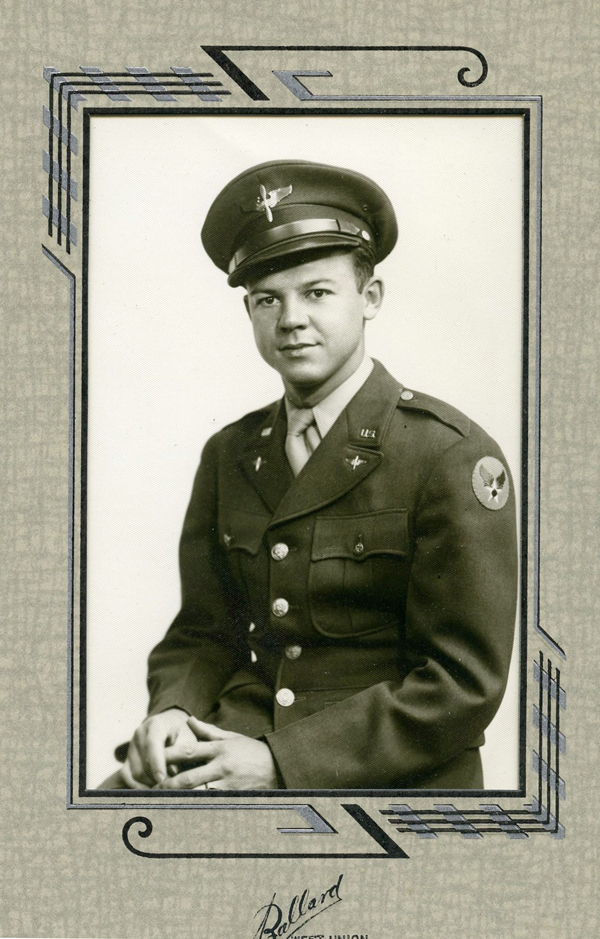
Maisie Woolnough
It was with great sadness we learned that our friend Maisie Woolnough passed away on 25th April, at the age of 91. Some of you will know that Maisie was a Land Girl and lived in Holton Hall... just after the Americans had moved out ! Maisie was proud of her service and she donated a replica land girl model complete with Maisie’s own badges to the museum. Maisie and her late husband Brian also used to host American veterans during local Reunions. For many years, Maisie raised money for both the Museum and the local branch of the British Legion. Due to the Covid19 funeral restrictions, Maisie’s family thoughtfully arranged for the funeral cortege to drive through Halesworth so that her many friends could pay their respects. The cortege also drove slowly past the Airfield museum and stopped at the memorial site for a few moments. All the museum volunteers were there to pay our respects to a wonderful lady and a great friend.
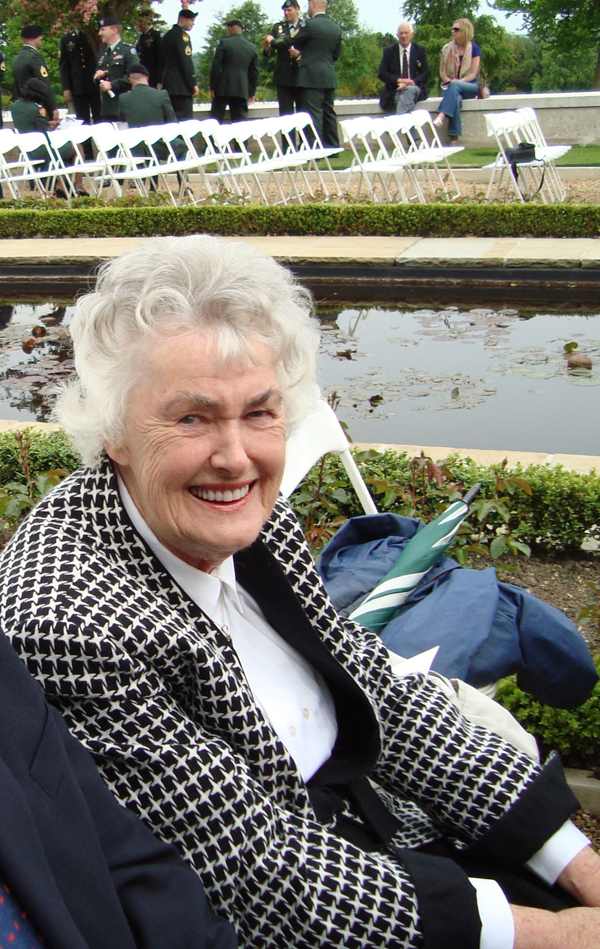
Jesus V Maldonado
We were informed by the family of 489th veteran Jesus Maldonado that he had passed away on 21 April 2020 at the age of 95. Jesus served at Halesworth during 1944. After his wartime service he worked as an electrician on experimental missiles, aircraft and the Apollo and lunar modules. He worked into his 80s with the US Forest Service. A life well lived.
Rosemary Thomas
Very sadly, we have learned that local Friend Rosemary Thomas passed away on 7 July. Rosemary and her late husband Ken (the Halesworth vet) hosted American visitors for our 489th Reunions. They also visited America to attend some of the Second Air Division Conventions many years ago. She was a very gentle and gracious lady and a good friend.
FROM OUR FACEBOOK PAGE (Edited by Paul Starks)
On 1 February 2020
Video: ‘The Men Who Flew the Liberators’ an Anglia TV Film written by Ron Olson and narrated by Dick Graham. Featuring WWII footage of the airfields and B24s and interview with Lt Johnnie Godwin, a Pilot from the 489th who was, at the time of filming (1972?), the Base Commander at USAF Mildenhall.
This film was sent to us by the son of Lt Godwin and it is still possible to view it on our Facebook page.
COMMEMORATION at WESTHALL VILLAGE HALL
To mark the 75th Anniversary of the crash on 24 March 1945 of the B17 “I’ll be Seeing You” (401st Bomb Group, 612 Bomb Squadron).
The Commemoration had been arranged before the Covid19 virus became widespread. Ronda Pasetti, cousin of Sgt Gene M Feo Jr who was lost that day, had planned to be present, but sadly this was not possible. However, the crew were remembered on 24 March 2020, when a wreath was placed beside the memorial plaque in the village of Westhall.
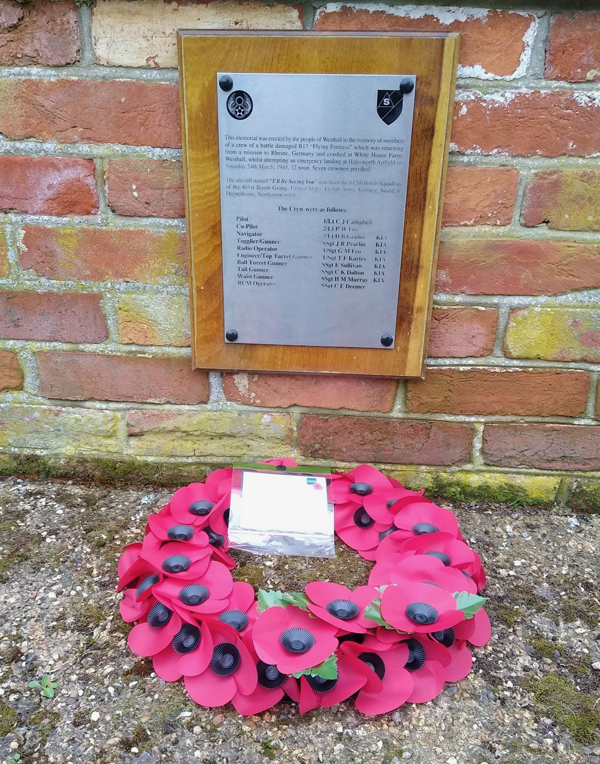
V E Day CELEBRATIONS and MEMORIAL Day at the Cambridge American Cemetery
These events were both cancelled due to the Covid19 restrictions. However, the Cemetery team put out a moving video for viewing on Memorial Day. This can be viewed from our Facebook page.
We remembered our fallen that day by raising the flag over the Halesworth Airfield Memorials and placing our tributes on each of these three memorials. To the 56th Fighter Group, to the 489th Bomb Group and to the 5th Emergency Rescue Squadron.
MISCELLANEOUS
* If you have anything you would like to share for our next Newsletter, please let us know via the museum link. Mark your subject ‘Newsletter’.
* If you would like to read further about the Groups who served on our airfield, there are several books available. Most of these can be bought from the internet, with one available for purchase on our own Museum website.
BOOKS on the 56th FG
From the ‘Fighting Units in Colour’ series:
56th Fighter Group Part 1: Kings Cliffe Kindergarten – Halesworth Heyday written by Nigel Julian and Peter Randall. Available from the Museum website here.
Out in Front: A Polish Fighter Pilot’s Dramatic Air War – Witold ‘Lanny’ Lanowski; Published by Fighting High Ltd, 2014.
BOOKS WRITTEN BY 489TH BG VETERANS
A History of the 489th Bomb Group by Charles H Freudenthal; American Spirit Graphics Corp.
Death Denied by Keith Turnham; Fairdale Publishing
In Hostile Skies – An American B-24 Pilot in World War II by James M Davis; University of North Texas Press
The Wrong Side of the Fence: a United States Army Air Corps POW in World War II by Eugene E Halmos Jr; White Mane Publishing Company.
Just An 18 Year Old During World War II by Earl Sutherland; Published by Lulu, Morrisville, NC. www.lulu.com
The Storm Clouds of War, Reflections of a World War II Bomber Pilot by Wilmer Plate; Published by Vilnius Press LLC, Portsmouth, NI.
FACEBOOK PAGE
There continues to be an incredible amount of interest in our Museum’s FACEBOOK page, mostly from our American veterans’ families. You can visit the Facebook page by clicking here.
All Newsletter correspondence to:
Halesworth Airfield Memorial Museum
Sparrowhawk Road
Upper Holton
Halesworth
IP19 8NH
Telephone 01986 835835 (answer machine)
www.halesworthairfieldmuseum.co.uk
email: info@halesworthairfieldmuseum.co.uk
Please note that all pictures and text within this publication are the copyright of the Halesworth Airfield Museum and must not be used, copied or distributed in any way without permission in writing from the Editor and Committee.



